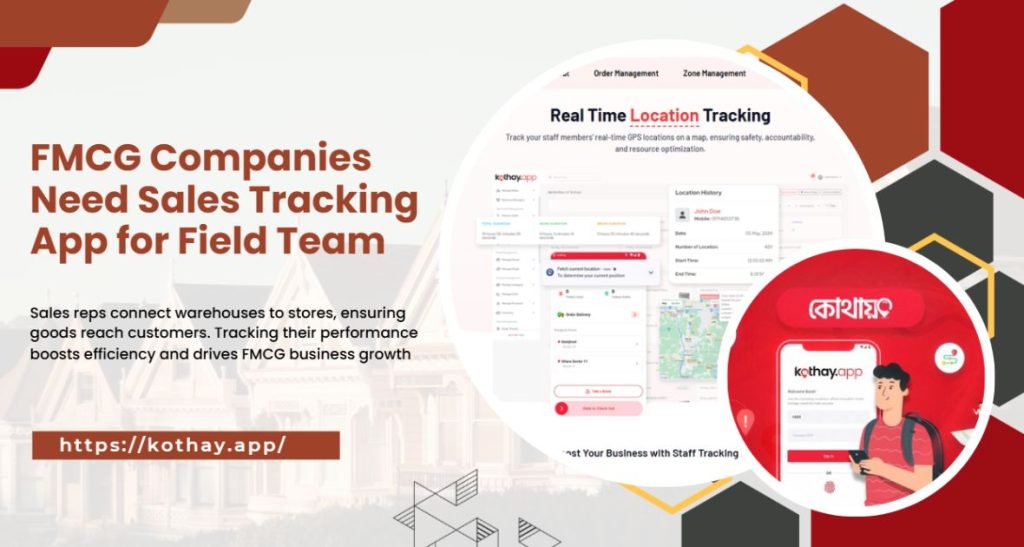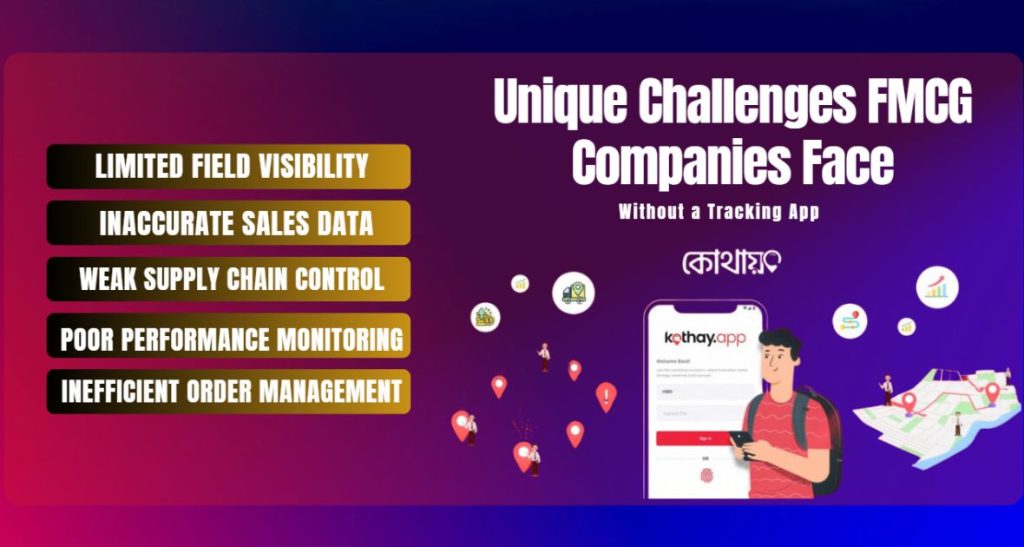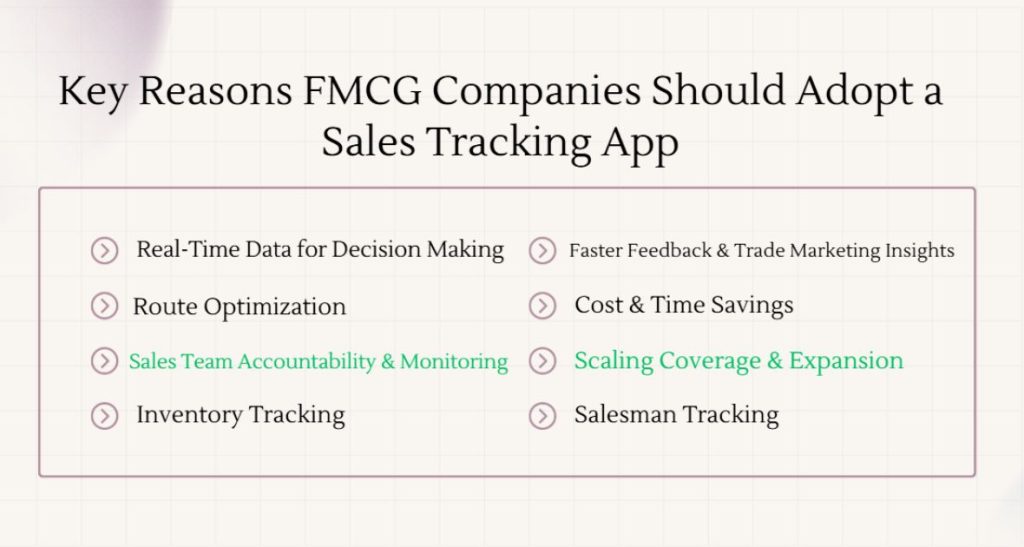AI for Employee and Salesman Tracking: A Comp
Tracking a large group of employees and sales team isn�...

Sales reps are the bridge between the warehouse and stores. They ensure your goods are delivered to local stores from where your consumers will purchase. Tracking how they work and what they achieve helps you manage your company’s growth efficiently.
Most FMCG companies in Bangladesh have large pools of sales reps. Each of them visits at least a hundred shops every day to meet their KPIs. When companies start collecting their performance data and sales reports on paper, they face difficulties like duplicate or wrong data, delayed reporting, unstructured data, and time-consuming manual work for decision-making.
When you use a dedicated field sales tracking app for FMCG, everything comes under one roof. The centralized system lets fast fast-moving consumer goods sector make data-driven decisions without tons of hard work. You won’t let your field force fabricate or misinterpret any detail when you integrate field force management software.
The numbers you get from FMCG sales tracking software or sales automation tools tell you where your growth is going, what the obstacles are, why the progress is in this condition, who needs improvement, and when you take the next action.
So, let’s tell you why FMCG companies need a mobile sales app like Kothay to scale up.

Different FMCG brands struggle with many field execution issues. Many retail outlets lie across wide territories. You find it hard to check if your reps visit them consistently. Without field sales tracking software, you depend on end-of-day summaries. Delays or inaccuracies sneak in.
You often lack accurate data from distributors or secondary sales. That means trends may hide until monthly reviews. Route planning becomes guesswork. Outlet coverage may remain uneven. Your ability to compare actual sales versus target quotas per rep becomes weak.
You miss insights about which outlets respond to promotions or follow-up schemes. Without a sales team tracking app, you can’t easily see if your secondary sales (through distributors) are underperforming. All of these add friction to growth in a fast-moving consumer goods industry.

Before you decide on tools, let me walk you through the main benefits you’ll actually see when you use field force management software/sales tracking app in your FMCG business.
With a field sales monitoring app, you access updates instantly: visit status, order placement, stock level, and scheme usage. That visibility lets you spot under-performing routes or reps without waiting. You can reduce missed visits and order delays via KPI tracking.
Routing and scheduling with integrated Google Maps will make sure your field force is moving accordingly. Employees can save time and visit more outlets without getting lost.
You don’t need to go through big files and sheets to make a decision on a sales rep’s performance. Metrics like number of visits, hours of working, conversion rates, order values, etc., are shown on the employee’s profile in your dashboard. It will increase accountability in your team.
The FMCG distribution management system and mobile sales app will let the admin see the number of orders from an outlet, stock status, and product trends. You can forecast demand and avoid having stockouts of popular items.
You collect merchandising feedback, photos of display execution, or scheme compliance at outlets. That helps you understand how promotions perform at the retailer level and helps you adjust campaigns faster.
There’s no need for paperwork if you adopt the digital transformation in FMCG. You can streamline sales operations with fewer errors. The FMCG sales monitoring app will automatically track activities and create error-free reports for the management team.
When you move into new areas or hire more reps or distributors, having a field reporting app or field sales management software makes onboarding easier. You maintain oversight even over remote or rural teams.
All together, those reasons translate into growth: increased sales efficiency, improved field sales productivity, and measurable sales growth in the FMCG sector.
There are several sales rep performance tracking apps in the market. To find out which one is the best FMCG sales monitoring app for you, look for these features.
The first condition of a sales tracking app is to offer location tracking software powered by powerful systems like Google Maps. You can know where your sales reps are and which stores they visited. Geo-fencing lets you monitor and validate every on-fiend activity.
You need route or beat-plan modules that assign which stores your rep should visit in which order. That helps you reduce travel time and improve the number of store calls per day.
In rural or low-network places, connectivity may be intermittent. A mobile sales app for FMCG must allow offline logging of visits or orders that sync later when the connection returns.
Your reps should be able to place orders from their phones, record payments, or returns. Digital receipt or invoice generation at the point of sale improves speed and accuracy.
You require dashboards that show visits per rep, sales vs target, conversion percentage, and weekly or monthly summaries. That helps you review and adjust performance.
Every visit, every change in order or route must leave an audit trail. That helps you track compliance and ensures data integrity.
Live notifications and alerts help team leaders take action instantly if any activity seems suspicious. Live alerts in the field reporting app will prevent issues from becoming big.
You want daily/weekly/monthly reports exportable to Excel or other tools. Also, integration with your inventory system or distributor’s data helps unify information flow.
These features ensure your investment in an FMCG field sales management software pays off by supporting both oversight and action.
Now, let’s talk about how you can measure benefits from the field sales tracking app for FMCG.
At first, you have to measure baseline metrics before the app. For example, the average visits per rep every day. Order conversion rate, hours spent on manual reporting, number of visits missed, etc. Then, after using the best sales tracking app for the FMCG industry (like Kothay), see the percentage of improvement.
For example, imagine a small FMCG brand with 50 field reps. Before you start the app, you average 15 visits per rep per day, conversion rate of 40 %. After you deploy the tracking app and optimize route planning, you raise visits to 18 per day (+20%), the conversion rate climbs to 45%, and reporting time drops by 50 %. If the average order value per visit is $10, that increment can lead to tens of thousands more revenue monthly.
You can also measure cost savings from travel time, fuel, and reduced errors. You track gains via dashboard metrics in your sales tracking software. That gives you a tangible way to compare investment cost vs upside.
Bangladesh has some special context you must address. Rural roads are numerous. Connectivity may drop in remote areas. Many retail outlets are informal or small. Your field reps may prefer training in the local language or need a simple UI.
Choose a mobile-first tool with offline features. Make sure the app supports a Bengali interface or simple icons. Field force management software must allow for irregular internet. Also, you may have cultural questions about accepting phone-time tracking.
Consider piloting the app in one district before rolling it out nationwide. Use local feedback to refine workflows. A tool like Kothay can help you manage that deployment because it supports offline usage, mobile sales app features, route planning, and visit tracking in Bangladesh.
You can pair the app with your distributor network. Even small FMCG brands in Bangladesh can scale faster if you monitor field rep performance and route compliance via software.
You need more than software. Implementation has to succeed. Get stakeholder buy-in from senior management and operations teams. Define KPIs: daily visits, order volumes, outlet coverage.
At first, train your sales reps to streamline sales operations with sales rep performance tracking software. Set clear goals for each team in the department. You should also promise rewards based on performance for sales growth in the FMCG sector.
Always measure the primary sales tracking metrics like login rates, check-in compliance, target status, etc. If any field sales representatives don’t feel comfortable with the field reporting app, encourage them.
Let me paint two quick examples. First, imagine a regional FMCG brand in South Asia that implemented a field sales monitoring app. After six months, it increased outlet coverage by 15 % and order value per rep by 12 %. That change came because route optimization freed up travel time and allowed reps to visit more stores with promotions.
Second, suppose a small dairy or snack brand in Bangladesh piloted Kothay in a few districts. They found that reps met 10% more outlets per day, and overall monthly sales grew by 8%. Managers could detect underserved retail zones and reassign coverage. Those shifts came directly because they saw holes in the dashboard each morning.
Both cases show that behavior changes when you give real-time feedback to field staff, measure activity daily, and connect that to targets.
Kothay is a field sales tracking app built for FMCG teams in Bangladesh. It supports GPS-verified check-ins, beat planning and route management, offline data capture, and detailed performance dashboards.
With Kothay’s field force management software, you can monitor how many visits each rep completed, how those visits convert into orders, and compare target vs achieved in near real time. That helps you increase sales efficiency and streamline sales operations across territories.
If you want to scale your FMCG business and keep your field team accountable and productive, explore how Kothay can help you modernize your processes and grow faster.
Why does FMCG need field sales tracking software?
A tracking app centralizes the sales rep monitoring and reporting jobs and allows team leaders to track their live status before anything turns out to be a major issue in the sales pipeline.
What metrics should FMCG companies monitor in a sales tracking app?
A FMCG company should monitor visits per day, conversion rates, outlets covered, delays, and target status.
Can sales tracking apps work without internet connectivity?
Yes, some sales tracking apps let users run the system without a strong internet connection. The data saved online will be uploaded when the device is online.
How do you ensure field teams follow their assigned routes?
Use route or beat-planning tools plus GPS / geo-fencing and check-in data. You compare expected vs actual visit path via the app dashboard.
Is it expensive for small FMCG brands to use a sales tracking app?
Costs vary by feature and scale, but many cloud-based field activity tracking tools offer subscription-based pricing. Pilot usage helps you estimate cost vs benefit before full rollout.
FMCG companies today face tight margins, many outlets, and fast competition. You need visibility, accountability, and agility in your field operations. A mobile sales tracking app for FMCG delivers those advantages by improving performance, cutting errors, and boosting efficiency.
If you’re ready to modernize your FMCG field sales operations and monitor your sales reps with real-time accountability, explore Kothay today to see how your business can scale smarter.